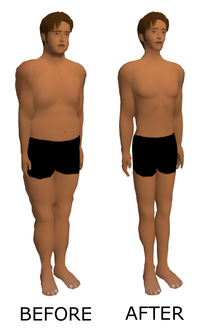
Photo from wikipedia
Abstract Objectives The effect of calorie restriction (CR) on cognitive function is controversial, and the effects of consuming a healthy dietary pattern during CR have not been investigated. Furthermore, there… Click to show full abstract
Abstract Objectives The effect of calorie restriction (CR) on cognitive function is controversial, and the effects of consuming a healthy dietary pattern during CR have not been investigated. Furthermore, there is no consensus on what dietary pattern may be the most beneficial for cognition. We analyzed the combined effects of CR and self-selected diet on measures of spatial working memory (SWM) in healthy adults without obesity. Methods Publicly available data from the CALERIE trial were analyzed. Participants were randomized to a 2-year CR intervention (n = 143) or an ad libitum Control (n = 76). Food records were collected at baseline, 12, and 24 months. The Dietary Inflammatory Index (DII) and the Healthy Eating Index (HEI-2015) were calculated to quantify different measures of dietary healthfulness, where a lower DII and a higher HEI-2015 indicate a healthier score. Cognitive function was assessed by the CANTAB battery, with fewer errors indicating better SWM. Changes in each index during the intervention were assessed by linear mixed models. Longitudinal associations between the indices and SWM were assessed by multivariable negative binomial models. Results On average, participants were 38.1 ± 7.2 years old with a BMI of 25.1 ± 1.7 kg/m2. The average DII and HEI-2015 scores at baseline were −0.47 (range: −4.02, 3.19) and 59.1 (24.1, 91.0) and did not significantly differ between groups. Improvements in DII and HEI-2015 were significantly different between CR and Control over time (P interaction < 0.0001), with greater improvements in CR. In longitudinal analyses, there was no significant effect of improving the healthfulness of the DII or HEI-2015 on SWM. In addition, though there were significant within-group improvements in SWM at 12 months, there was no significant difference between the changes observed in CR (adjusted mean difference: 10.0; 95% CI: 2.2, 45.7) and Control (13.1; 95% CI: 2.9, 59.3; P = 0.93). Comparable results were observed at 24 months. Conclusions Neither CR nor the healthfulness of the diet were associated with SWM, suggesting that that the potential for CR and dietary patterns to have beneficial effects on working memory may be limited in healthy populations. Further research is required to understand the role of diet in cognitive function in at-risk populations. Funding Sources Jean Mayer USDA HNRCA Doctoral Scholarship; USDA agreement #8050-51,000-105-01S.
Journal Title: Current Developments in Nutrition
Year Published: 2022
Link to full text (if available)
Share on Social Media: Sign Up to like & get
recommendations!